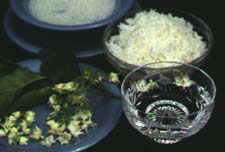Human Flower Project
Thursday, May 04, 2006
Chilling with Khao Chae
Jasmine flowers and cooled rice help to weather the long summer, Thai-style.
After yet another disgusting restaurant experience last night, we vow to cook more and dine out less this summer. We’ll be emitting less exhaust and exposed to fewer unbidden renditions of “Love the One You’re With” (Austin is the “Live Music Capitol of the World,” which is not to say good music).
 Khao chae
Khao chae
Photo: Minoru Watanabe
via Asia Rice Foundation
Our first culinary ambition is Khao Chae. A delicacy of Thailand, it combines two of our favorite things in the world: rice and jasmine flowers. And much to recommend it as a Texas dish, it’s cool.
Khao chae (rice, soaked) has long been a specialty of the ethnic Mon, of Thailand’s Central Plains. They prepared it ceremonially for the Songkran, offering it with other gifts to “the female guardian spirit of the New Year.” In the 19th century, the homestyle recipe was adapted by the Thai nobility since it is a) tasty b) refreshingly cool as Thailand is hot, and c) quite complicated to prepare, so fit for a king.
Here is one recipe from Takako Mashiko:
“Ordinary jasmine rice is too soft, so the firmer khao taa haeng variety is used. It is first cooked in the normal way and then put in a colander and rinsed under running water several times to remove the excess starch.
“Then comes the unique ingredient: flower-scented water. A large pot is half-filled with water and a handful or two of fresh jasmine blossoms added. Then a small flower-scented candle is floated on top of the water, lit, and the pot covered loosely with the lid for 15 minutes. More blossoms and a candle with a different scent are then added and left for another 15 minutes—and then done for a third time. The scent from the candles and the natural oils from the jasmine should permeate the water.
“Sprinkle the rice liberally with scented water, then put into a piece of cheesecloth, twist the ends together to make a tight bundle and tie a knot in the top to stop the rice from swelling. Steam over boiling water. To serve, transfer some of the rice into a bowl, cover with more of the fragrant water and add a few small ice cubes and some of the flowers.”
Think of it as Thrice-Smoked Flower Rice and you begin to get the princely sense of it all. Traditional side dishes “include peanut-sized luuk kapi (shrimp paste balls), phrik yuak (fried pork-stuffed large hot peppers), hawm thawt (fried shallots), nuea phat waan (beef), and hua chai poe (Chinese radish).”
Funkygradstudent has gone hunting for khao chae in Singapore and come up hot and empty-handed. The Thai restaurants there told Funky “that special equipment and skill is required ”—it’s just too labor-intensive.
Which gets us back to dining at home. We’ve spotted a neighbor’s jasmine vine looking lush with blooms. This weekend, we even stand to capture a bit of rainwater, which some khao chae recipes recommend. Candles: check. Earthenware container: check. Rice: check. We’re ready, and the mercury is rising.




